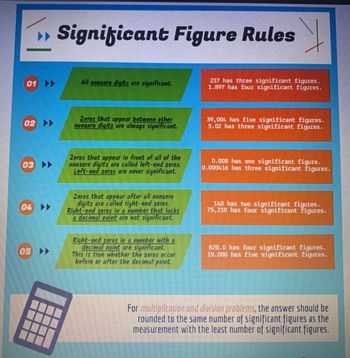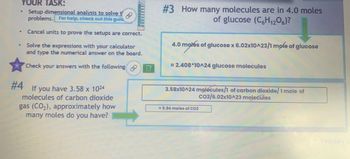
Chemistry
10th Edition
ISBN: 9781305957404
Author: Steven S. Zumdahl, Susan A. Zumdahl, Donald J. DeCoste
Publisher: Cengage Learning
expand_more
expand_more
format_list_bulleted
Question

Transcribed Image Text:01 ▶▶
02
03 >>
04 >>
05 >>
Significant Figure Rules
Rules
All nonzero digits are significant.
Zeros that appear between other
nonzero digits are always significant.
Zeros that appear in front of all of the
nonzero digits are called left-end zeros.
Left-end zeros are never significant.
Zeros that appear after all nonzero
digits are called right-end zeros.
Right-end zeros in a number that lacks
a decimal point are not significant.
Right-end zeros in a number with a
decimal point are significant.
This is true whether the zeros occur
before or after the decimal point.
237 has three significant figures.
1.897 has four significant figures.
39,004 has five significant figures.
5.02 has three significant figures.
0.008 has one significant figure.
0.000416 has three significant figures.
140 has two significant figures.
75,210 has four significant Ligures.
620.0 has four significant figures.
19.000 has five significant figures.
For multiplication and division problems, the answer should be
rounded to the same number of significant figures as the
measurement with the least number of significant figures.

Transcribed Image Text:YOUR TASK:
Setup dimensional analysis to solve t
problems. For help, check out this gula
Cancel units to prove the setups are correct.
Solve the expressions with your calculator
and type the numerical answer on the board.
☆
Check your answers with the following
#4 If you have 3.58 x 10²4
molecules of carbon dioxide
gas (CO₂), approximately how
many moles do you have?
CD
#3 How many molecules are in 4.0 moles
of glucose (C6H₁206)?
4.0 molés of glucose x 6.02x10^23/1 mole of glucose
= 2.408*10^24 glucose molecules
3.58x10^24 molecules/1 of carbon dioxide/1 mole of
co2/6.02x10^23 molecules
5.94 moles of CO2
February 2
Expert Solution
This question has been solved!
Explore an expertly crafted, step-by-step solution for a thorough understanding of key concepts.
This is a popular solution
Trending nowThis is a popular solution!
Step by stepSolved in 3 steps with 2 images

Knowledge Booster
Learn more about
Need a deep-dive on the concept behind this application? Look no further. Learn more about this topic, chemistry and related others by exploring similar questions and additional content below.Similar questions
- This Is the chemical formula for talc (the main Ingredient In talcum powder): Mg,(Si,0,),(OH), An analytical chemist has determined by measurements that there are 0.064 moles of oxygen in a sample of talc. How many moles of hydrogen are In the sample? Round your answer to 2 significant digits. O mol x10arrow_forwardBlank #1) Calculate the mass of 1.98 moles of Li₂SO3 in grams. Report you answer with three sig.figs. Blank #2) Show your conversion factor set-up in the second blank. Use this format: 200 minutes X (1 hour/60 minutes) X (1 day/24 hours) Blank #1 Blank #2 Question 7 (4 points) Listen Blank #1) One tablet of aspirin, C9H8O4, contains 0.0212 moles. How many grams is this? Report your answer with three sig.figs. Blank #2) Show your conversion factor set-up in the second blank. Use this format: 200 minutes X (1 hour/60 minutes) X (1 day/24 hours) Blank # 1 Blank # 2 A Aarrow_forwardi didnt mean to clicked on the choicearrow_forward
- O CHEMICAL REACTIONS 3/5 Finding mole ratios from chemical formulae This is the chemical formula for methyl tert-butyl ether (the clean-fuel gasoline additive MTBE): CH,OC(CH,), A chemical engineer has determined by measurements that there are 6.6 moles of carbon in a sample of methyl tert-butyl ether. How many moles of hydroger are in the sample? Be sure your answer has the correct number of significant digits. mol Explanation Check © 2022 McGraw Hill LLC. All Rights Reserved. Terms of Use Privacy Center 28°C Mostly cloudy pe here to search USarrow_forwardI am not sure how to do the matharrow_forwardAnswer this question in the same format thats in the picture below on paper, answer correctly.Question: how many grams are in 1.73 mol of dinitrogen pentoxide (N2O5)arrow_forward
- Using the numbers below how do I set this up to get the correct answer?arrow_forwardBe sure to answer all parts. Calculate the number of H ions in 22.1 g of SrH. x10 Enter your answer in scientific notation.arrow_forwardMolar Masses A = 256.03– E = 157.45mole D = 194.68 X = 276.25mole mole mole G = 192.47mole Z = 162.05–9 mole If 13.41 g A are reacted with 12.53 g D, according to the balanced chemical equation below, how many grams of G will be produced? 4 A + 3 D – 6 Z + 6 G Please input your answer to the third decimal place Type your answer...arrow_forward
- NH How many grams of 3 are in 2.5 mol of Show your work. Be sure each step is written out clearly. H Normal E E A A @ Enter your answer here ==== NH 3? 5 BIUS √x 2 2 Ixarrow_forwardPleasearrow_forwardThe molecular formula of remdesivir is C27H35N6O8P. How many nitrogen atoms are in 6.4555 moles of remdesivir? Enter your response rounded to 3 significant figures.arrow_forward
arrow_back_ios
arrow_forward_ios
Recommended textbooks for you
 ChemistryChemistryISBN:9781305957404Author:Steven S. Zumdahl, Susan A. Zumdahl, Donald J. DeCostePublisher:Cengage Learning
ChemistryChemistryISBN:9781305957404Author:Steven S. Zumdahl, Susan A. Zumdahl, Donald J. DeCostePublisher:Cengage Learning ChemistryChemistryISBN:9781259911156Author:Raymond Chang Dr., Jason Overby ProfessorPublisher:McGraw-Hill Education
ChemistryChemistryISBN:9781259911156Author:Raymond Chang Dr., Jason Overby ProfessorPublisher:McGraw-Hill Education Principles of Instrumental AnalysisChemistryISBN:9781305577213Author:Douglas A. Skoog, F. James Holler, Stanley R. CrouchPublisher:Cengage Learning
Principles of Instrumental AnalysisChemistryISBN:9781305577213Author:Douglas A. Skoog, F. James Holler, Stanley R. CrouchPublisher:Cengage Learning Organic ChemistryChemistryISBN:9780078021558Author:Janice Gorzynski Smith Dr.Publisher:McGraw-Hill Education
Organic ChemistryChemistryISBN:9780078021558Author:Janice Gorzynski Smith Dr.Publisher:McGraw-Hill Education Chemistry: Principles and ReactionsChemistryISBN:9781305079373Author:William L. Masterton, Cecile N. HurleyPublisher:Cengage Learning
Chemistry: Principles and ReactionsChemistryISBN:9781305079373Author:William L. Masterton, Cecile N. HurleyPublisher:Cengage Learning Elementary Principles of Chemical Processes, Bind...ChemistryISBN:9781118431221Author:Richard M. Felder, Ronald W. Rousseau, Lisa G. BullardPublisher:WILEY
Elementary Principles of Chemical Processes, Bind...ChemistryISBN:9781118431221Author:Richard M. Felder, Ronald W. Rousseau, Lisa G. BullardPublisher:WILEY

Chemistry
Chemistry
ISBN:9781305957404
Author:Steven S. Zumdahl, Susan A. Zumdahl, Donald J. DeCoste
Publisher:Cengage Learning

Chemistry
Chemistry
ISBN:9781259911156
Author:Raymond Chang Dr., Jason Overby Professor
Publisher:McGraw-Hill Education

Principles of Instrumental Analysis
Chemistry
ISBN:9781305577213
Author:Douglas A. Skoog, F. James Holler, Stanley R. Crouch
Publisher:Cengage Learning

Organic Chemistry
Chemistry
ISBN:9780078021558
Author:Janice Gorzynski Smith Dr.
Publisher:McGraw-Hill Education

Chemistry: Principles and Reactions
Chemistry
ISBN:9781305079373
Author:William L. Masterton, Cecile N. Hurley
Publisher:Cengage Learning

Elementary Principles of Chemical Processes, Bind...
Chemistry
ISBN:9781118431221
Author:Richard M. Felder, Ronald W. Rousseau, Lisa G. Bullard
Publisher:WILEY